Key takeaways:
- Sourdough originated around 1500 BC in ancient Egypt and symbolizes resilience through history, serving as a source of nourishment in tough times.
- Key ingredients for sourdough include flour, water, and salt, with variations in flour type significantly affecting flavor and texture.
- Baking sourdough teaches patience, the acceptance of imperfection, and highlights the communal aspect of sharing bread with others.
- Successful sourdough relies on intuition regarding rising times and maintaining a consistent temperature during fermentation.
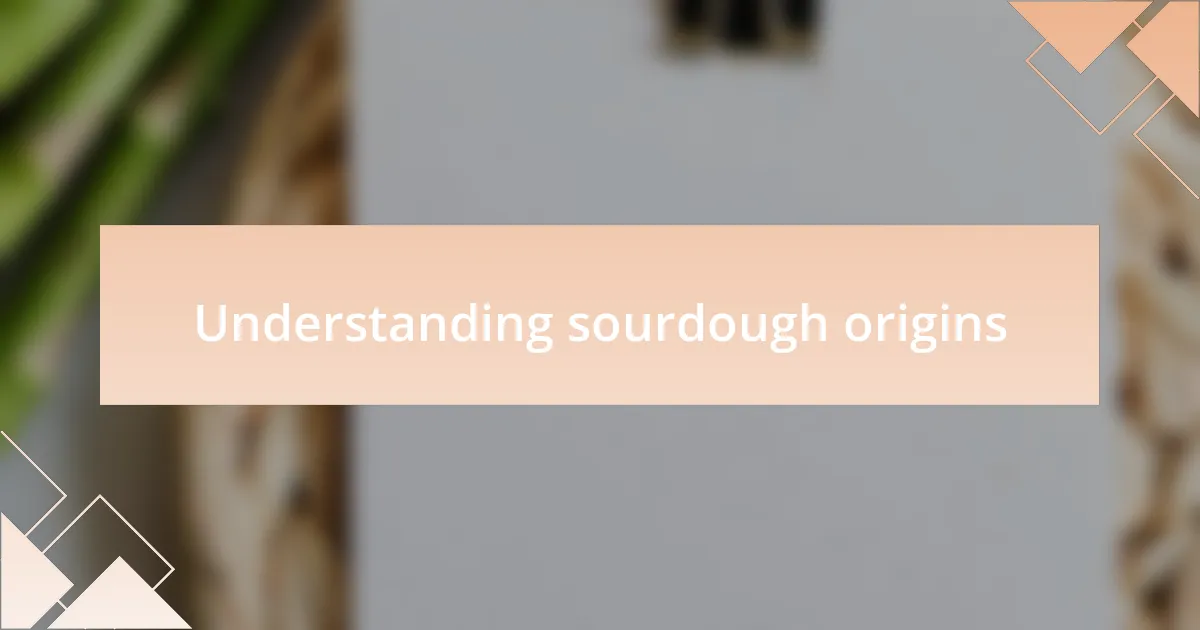
Understanding sourdough origins
Sourdough has a fascinating history that dates back thousands of years, believed to have originated in ancient Egypt around 1500 BC. I often wonder about the early bakers and how they stumbled upon the magic of wild fermentation. Just imagine the excitement of discovering that leaving flour and water out could lead to a bubbly, tangy starter—what a revelation that must have been!
As I dive deeper into the story of sourdough, I can’t help but feel a connection to those artisans of the past. Their methods were simple yet profound, relying on naturally occurring yeast and bacteria to transform basic ingredients into magnificent loaves. This organic process makes me reflect on the beauty of tradition and how recipes can be enriched by the communities that pass them down.
Throughout history, sourdough has served various purposes, from leavening bread to acting as a symbol of nourishment during tough times. I sometimes think about how, in the face of challenges, communities would come together to create something so vital. Doesn’t it give you a sense of comfort to imagine a warm loaf of sourdough bringing people together during periods of hardship?

Historical significance of sourdough
Sourdough’s historical significance extends beyond mere baking; it’s a representation of resilience through changing times. Consider how, during the California Gold Rush, prospectors carried their sourdough starters with them, relying on its reliable fermentation amid uncertainty. I sometimes imagine those hopeful individuals, kneading dough by campfires, believing in the comfort of home and familiar flavors despite the wild unknown surrounding them.
In many cultures, sourdough has been more than just a food source; it’s a cherished tradition passed from one generation to the next. I often recall my grandmother’s tales of handmade loaves, how she would say that the starter was like a family heirloom—a living artifact rich with stories. Isn’t it beautiful to think that each batch of sourdough brings with it a piece of history and connection to those who came before us?
Moreover, during times of war and scarcity, sourdough has served as a lifeline. I remember reading about how it became essential in Europe during World War I and II when rations were tight. The ability to create nourishing bread from simple ingredients demonstrates not only creativity but also the undying human spirit to flourish even in adversity. What does this tell us about the role of food in shaping community and identity?
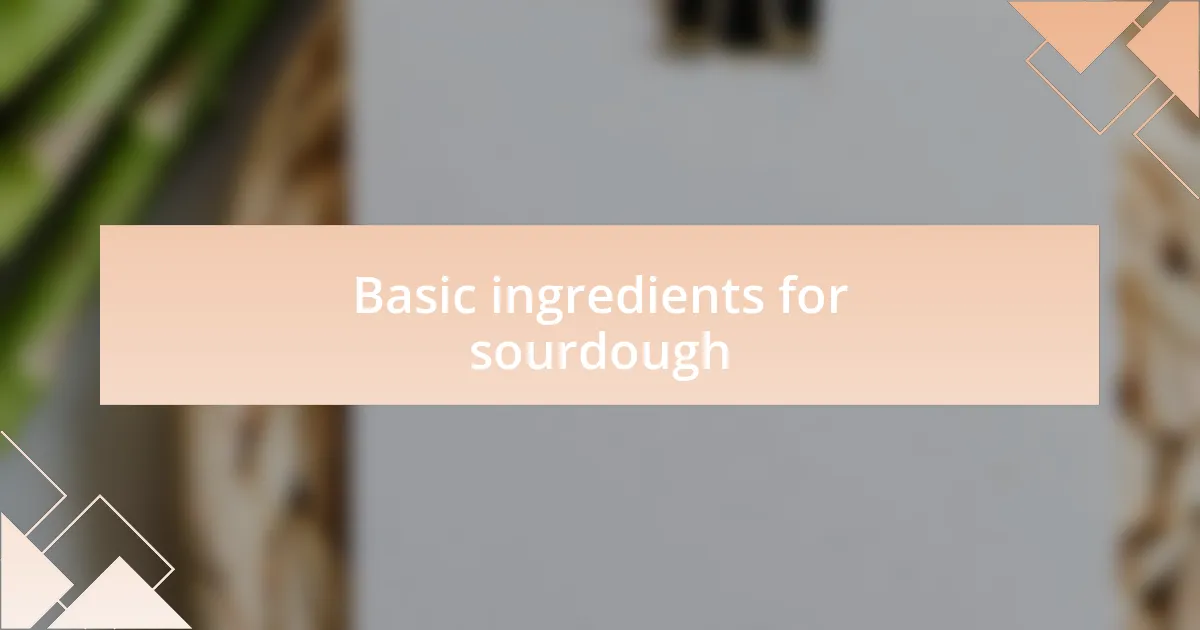
Basic ingredients for sourdough
When it comes to sourdough, the basic ingredients are quite simple yet powerful. You need flour, water, and salt; however, the type of flour can greatly influence the outcome. I remember experimenting with different flours and discovering that whole grain flour lends a richer flavor, while bread flour can create a chewier texture. Have you ever tried a loaf using rye flour? The depth it brings is just extraordinary.
Water is another critical ingredient, and its quality can’t be overlooked. Do you realize how different minerals in water affect fermentation? I once used filtered water versus tap water, and the difference in my starter’s activity was remarkable. It made me think about how the tiniest changes can lead to big flavors.
Lastly, salt is essential not just for flavor, but also for controlling the fermentation process. It’s fascinating how a pinch of salt can regulate yeast activity! In my baking experiences, I often play around with the salt ratios, and each time, it feels like I’m fine-tuning a delicate balance. Have you had a chance to experiment with your sourdough recipes yet? Each ingredient plays a role in crafting something uniquely yours.
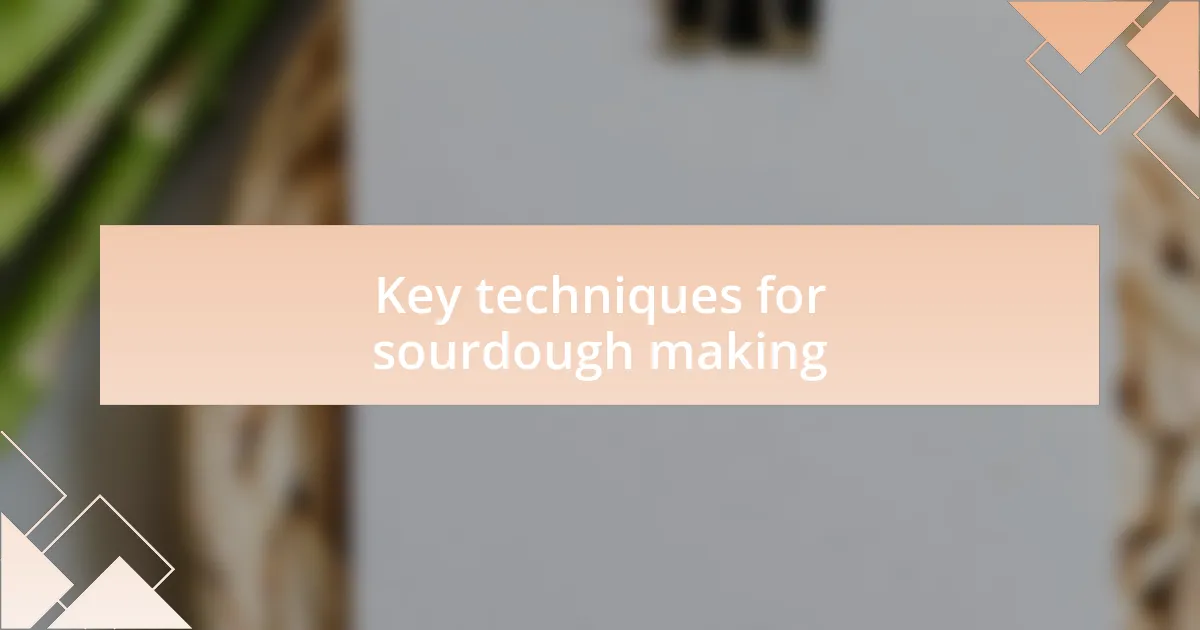
Key techniques for sourdough making
When it comes to mastering sourdough, understanding the fermentation process is crucial. I remember observing my first starter rise and fall, learning to recognize the signs of readiness. Have you ever felt that thrill when bubbles form and the aroma shifts from sweet to tangy? That’s the magic of wild yeast and bacteria working together, and it’s essential to let them develop fully for that characteristic sour flavor.
Kneading and folding techniques play an equally important role in shaping your dough. I’ve found that gentle stretch and folds during the bulk fermentation not only strengthen the gluten but also enhance the texture of the final loaf. It’s fascinating how this simple technique can transform a shaggy mass into a silky, elastic dough! Have you tried it yet? You might be surprised at how much better your sourdough can become.
Finally, mastering temperature control can elevate your sourdough game significantly. Whether you’re looking for a slower cold fermentation to develop complex flavors or a warm method for a quicker rise, I’ve experimented with both. There was a time when I underestimated the cold overnight rise, but tasting that deep, nutty flavor changed my perspective entirely. Isn’t it incredible how temperature plays such a pivotal role in crafting that perfect loaf?
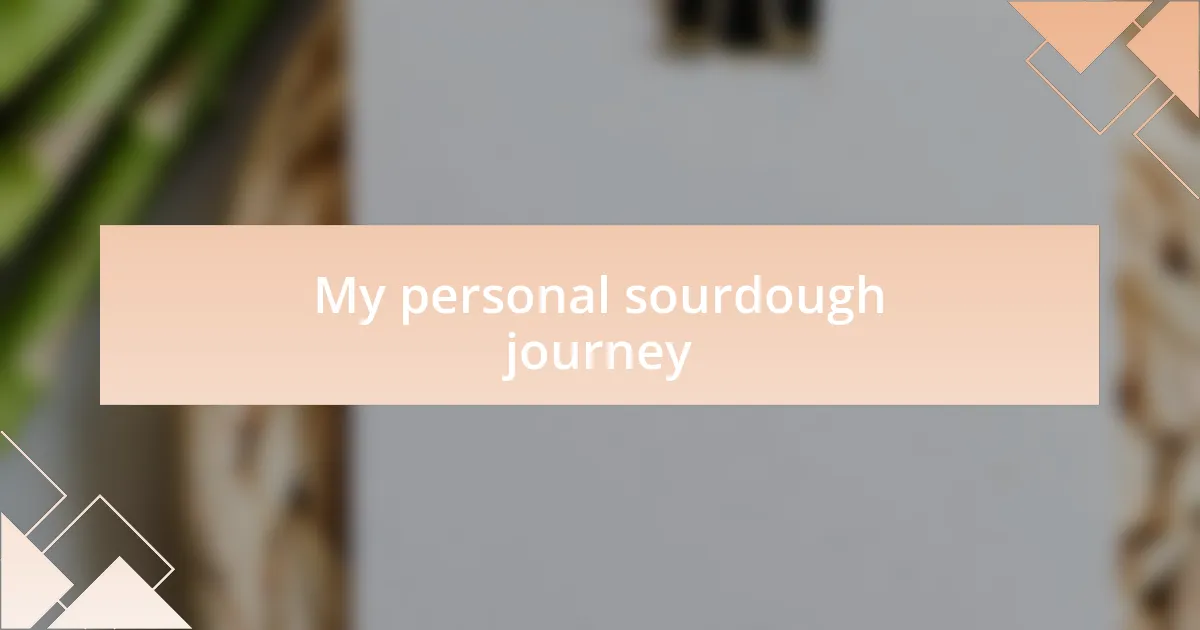
My personal sourdough journey
My personal sourdough journey started unexpectedly. I still recall the moment I decided to bring a bit of the bakery home with me after a particularly delightful visit to a local artisan bakery. I spent hours researching and eventually stumbled upon the concept of sourdough starter—was I really ready to embark on making my own? The thought excited me, yet I felt a twinge of apprehension.
As I mixed my first batch, I remember the sense of wonder I felt watching my starter come to life over days. Each bubble that appeared felt like a small victory, and the first time it doubled in size, I couldn’t help but do a little victory dance in my kitchen. Have you ever felt that kind of exhilaration over something so deceptively simple? It was as if I was nurturing a little pet, waiting eagerly for it to flourish.
With each loaf I shaped, I built not just skills but confidence. I have vivid memories of slicing into my first successful loaf—levels of crisp crust giving way to soft, airy insides, and that scent enveloping my kitchen. I often ask myself, how did something that once felt so challenging become such a gratifying routine? It’s been a beautiful journey of trial and error, but each bake brings me closer to mastering the art of sourdough.
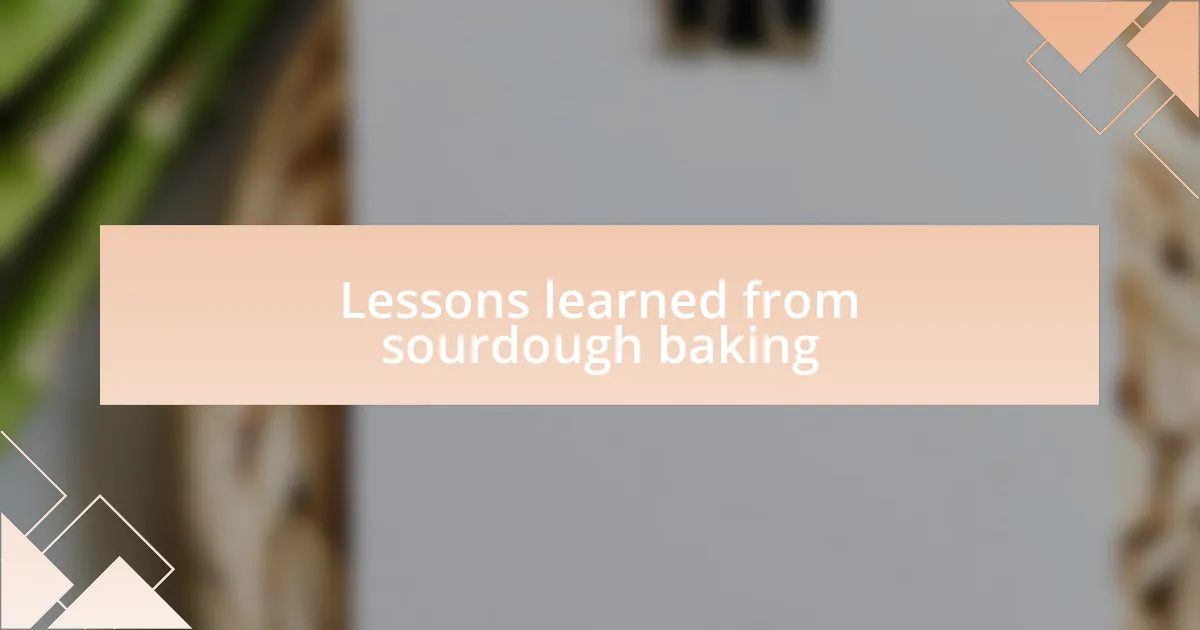
Lessons learned from sourdough baking
Baking sourdough has taught me the value of patience. I vividly recall the first time I neglected my starter for a few days; it felt like a small disaster at the time. Yet, restoring it and watching it thrive again reminded me that sometimes the best things take time and care, just like relationships in life. Isn’t it interesting how a loaf of bread can parallel our experiences?
Another lesson I’ve embraced is the beauty of imperfection. I distinctly remember my first few loaves—some were dense and deflated, far from the lofty creations I aimed for. Those “failures” taught me resilience and the importance of experimenting without fear of the outcome. Every loaf, regardless of its appearance, offered insights, making me appreciate every slice even more. How often do we let our mistakes discourage us, rather than see them as stepping stones?
The communal aspect of sourdough baking has also struck me profoundly. Sharing my loaves with friends and family transformed my home into a hub of connection. It was heartwarming to see their excitement when they took their first bites. I realized that through this simple act of baking, I’m not just feeding their bodies but also nurturing relationships. Isn’t it amazing how food can bring us together in such meaningful ways?
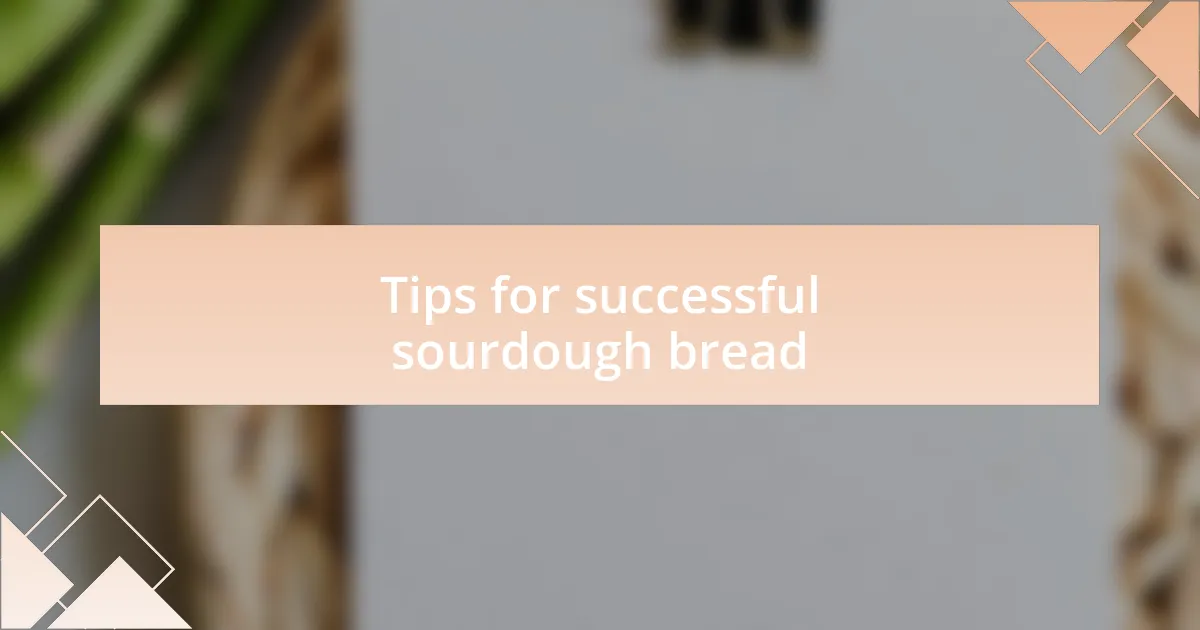
Tips for successful sourdough bread
When I first embarked on my sourdough journey, I quickly discovered the importance of the right flour. I found that using a higher protein bread flour, like a strong white flour, not only gives the bread structure but enhances its overall flavor. Have you ever experimented with different flours? I was amazed at how even a small change could lead to fascinating differences in taste and texture.
Another valuable tip I learned is to trust your instincts when it comes to rising times. Sometimes, the dough will tell you when it’s ready, rather than sticking to a strict timeline. On one occasion, I ignored the clock and let my dough rise until it almost doubled in size. The result was a beautifully airy loaf that completely took me by surprise. Have you found moments where intuition played a crucial role in your baking? These experiences transformed my baking approach from rigid to flexible, and it made a world of difference.
Finally, I can’t emphasize enough how critical it is to maintain a consistent temperature during fermentation. The first time I attempted to bake in a cooler kitchen, I ended up with a loaf that never quite rose as I had hoped. It taught me to create a warm, draft-free environment, whether that meant moving my dough near the oven or even using a proofing box. Have you ever had to adapt your process to suit your environment? That adaptability not only improved my bread but deepened my understanding of fermentation itself.